A Devonian alga with peculiar features
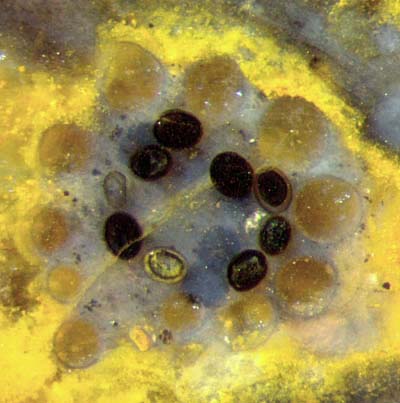 A Lower Devonian
alga with unique features has been found lying prostrate in an old
fragment of Rhynie chert. The sample is so narrow that it
could hardly contain larger
parts of the plant. Luckily, it shows about 20 structured
sections on the raw surface and on the cut faces,
apparently from upper regions of the plant. A well-oriented
cross-section is seen in Fig.1. The
3D-structure of this complex organ superficially resembling a flower
with stamens can be deduced from this
cross-section and from incomplete longitudinal sections, Figs.2,3. The
countless separate
sections of other twigs also seen on the faces are not suitable for a
reconstruction of the whole but suggest an interpretation as a
charophyte Green Alga.
A Lower Devonian
alga with unique features has been found lying prostrate in an old
fragment of Rhynie chert. The sample is so narrow that it
could hardly contain larger
parts of the plant. Luckily, it shows about 20 structured
sections on the raw surface and on the cut faces,
apparently from upper regions of the plant. A well-oriented
cross-section is seen in Fig.1. The
3D-structure of this complex organ superficially resembling a flower
with stamens can be deduced from this
cross-section and from incomplete longitudinal sections, Figs.2,3. The
countless separate
sections of other twigs also seen on the faces are not suitable for a
reconstruction of the whole but suggest an interpretation as a
charophyte Green Alga.
Fig.1 (right): Cross-section of the complex upper part of an unknown
alga: ellipsoidal
capsules in a basket made of 11 amber-coloured aligned twigs.
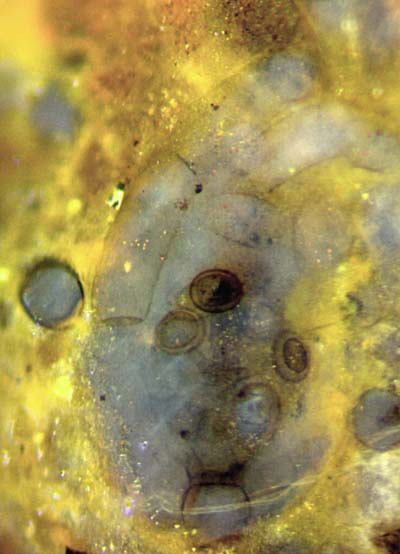
Figs.2,3
(left and below): Inclined sections of baskets made
of bluish twigs consisting of a few big cells in a row, serving as an
enclosure
for the capsules, which seem to be rotational ellipsoids with circle
diameter up to 130Ám. Width of Figs.1-6: 1mm.

The
basket made of twigs consisting of a few
cells each, ascending from a basal cell,
resembles similar formations with the charophyte alga Palaeonitella,
except for the apparent absence of any chirality in the present case.
What
is really enigmatic here is the capsules. Their arrangement like
stamens in a flower suggests an interpretation as
antheridia but an interpretation as oogonia has to be considered, too.
Anyway, the fossil remains
highly unusual for its organs on long slender stalks, about
20Ám x
150Ám as seen in Figs.2,4,5, which have never been found with
charophytes.
Tolypella
is the
only extant charophyte alga whose antheridia are borne on (short)
stalks.
Antheridia on slender stalks are known from species of the extant
bryophytes Porella,
Timmia, Sphagnum, Orthotrichum, Funaria [1].
Oogonia on long stalks are known from some Brown Algae, as Sargassum horneri,
but apparently not from Green Algae.
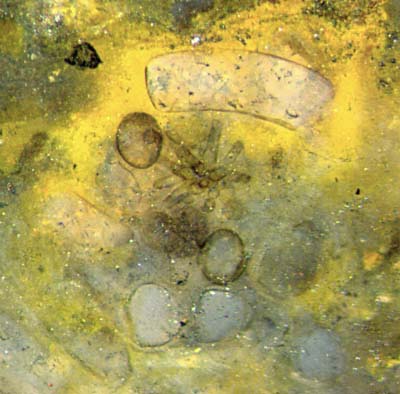
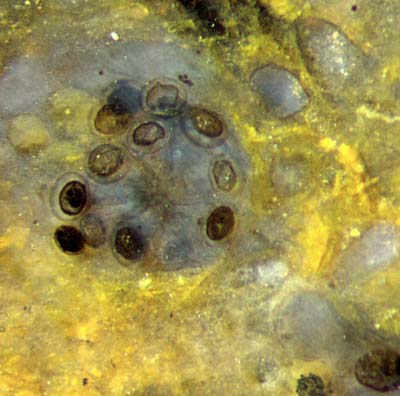
The basal cell of the basket serves
as a base for the upward-bent lateral twigs
and also for a central columella from which the stalks with the
capsules branch off. This
columella is seen in top view with slender stalks connected to some
of the 12 (?) capsules in Fig.4. (It is not known why they are smaller
than
those in the other pictures with the same scale.) The columella is seen
more clearly on the largely decayed specimen in
Fig.5, with about 10 capsule stalks
but only two capsules left. Not much is left of
the protective basket in Figs.4,5.
Fig.4: Cross-section near top similar as Fig.1,
capsules connected with slender stalks to
a central columella.
Fig.5 (far right): Top view of columella with stalks, most capsules
missing.
Fig.6 (below): Lateral view of a basket made of aligned twigs.
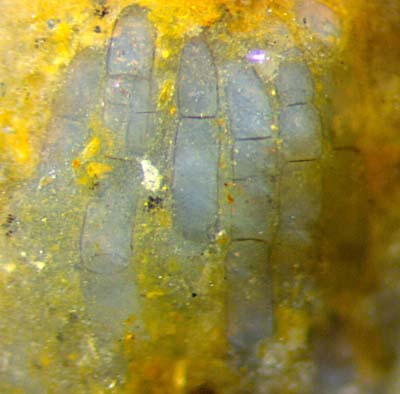
The
convex outside of the basket, here incidentally on the
sample surface, appears as 6 finger-like twigs in Fig.6. (One is poorly
seen in the shade on the right. The twigs are partially transparent so
that traces of 2 more twigs lying behind are vaguely seen through.) It
is
surprising that there are no capsules in the well preserved big basket,
otherwise they would be seen from outside through the twigs. Less
surprising are two small baskets, with 6 and 7 twigs, not shown here,
also without capsules.
It is not obvious what is seen inside the capsules. Some of them look
empty and transparent,
others are filled with black substance throughout. More interesting are
those with a smaller ellipsoid inside, well seen in Figs.2-4.
This could have been an inner cavity in a thick-walled ellipsoid, or
the organic fill of the thin-walled ellipsoid could have shrunk away
from the wall as a result of degradation. Granular fills and black
stains could have been brought about by secondary phenomena.
From the observations it can be concluded that the unknown alga ...
- produces barrel-shaped baskets,
about 1mm high and less than 1mm wide,
-- with finger-like twigs consisting of 4 to 5 (?) cells
100...170Ám wide,
-- with gaps left between the twigs,
-- without symmetry except for the
barrel shape, (*)
-- with a basal cell from which the twigs and a
columella arise,
--- the columella often producing capsules shaped as
rotational ellipsoids on long stalks.
The
branches consisting of big cells in single file resemble those of
extant and fossil charophytes,
as Palaeonitella,
and an earlier
described unknown alga from the Rhynie chert with another enigmatic
detail possibly related to reproduction. (See
Rhynie
Chert News 48.)
As an intriguing fact, the stalked capsules of the present fossil
differ much from any reproductive organ of
extant and fossil charophytes as we know them.
The present find confirms the supposition that branches
consisting of big alga cells like those of Palaeonitella do
not necessarily indicate a close relationship among the respective
fossil species.
All pictures (same scale and width of 1mm) have
been taken from the chert sample Rh10/42 (0.16 kg) found by S.
Weiss in 2013.
H.-J. Weiss
2015, modified
and corrected Oct. 2015
(*) Annotation 2019: Symmetry as suggested by Fig.1 seems to
be rather the exception than the rule. The asymmetry
in Figs.2,3
is not only due to the inclined cut but to a lopsidedness of the basket
protecting the capsules. (See also Rhynie Chert News 138.)
[1] G. Throm: Biologie der Kryptogamen II, p.523, 598.
 |
 |
73 |


 A Lower Devonian
alga with unique features has been found lying prostrate in an old
fragment of Rhynie chert. The sample is so narrow that it
could hardly contain larger
parts of the plant. Luckily, it shows about 20 structured
sections on the raw surface and on the cut faces,
apparently from upper regions of the plant. A well-oriented
cross-section is seen in Fig.1. The
3D-structure of this complex organ superficially resembling a flower
with stamens can be deduced from this
cross-section and from incomplete longitudinal sections, Figs.2,3. The
countless separate
sections of other twigs also seen on the faces are not suitable for a
reconstruction of the whole but suggest an interpretation as a
charophyte Green Alga.
A Lower Devonian
alga with unique features has been found lying prostrate in an old
fragment of Rhynie chert. The sample is so narrow that it
could hardly contain larger
parts of the plant. Luckily, it shows about 20 structured
sections on the raw surface and on the cut faces,
apparently from upper regions of the plant. A well-oriented
cross-section is seen in Fig.1. The
3D-structure of this complex organ superficially resembling a flower
with stamens can be deduced from this
cross-section and from incomplete longitudinal sections, Figs.2,3. The
countless separate
sections of other twigs also seen on the faces are not suitable for a
reconstruction of the whole but suggest an interpretation as a
charophyte Green Alga. 





